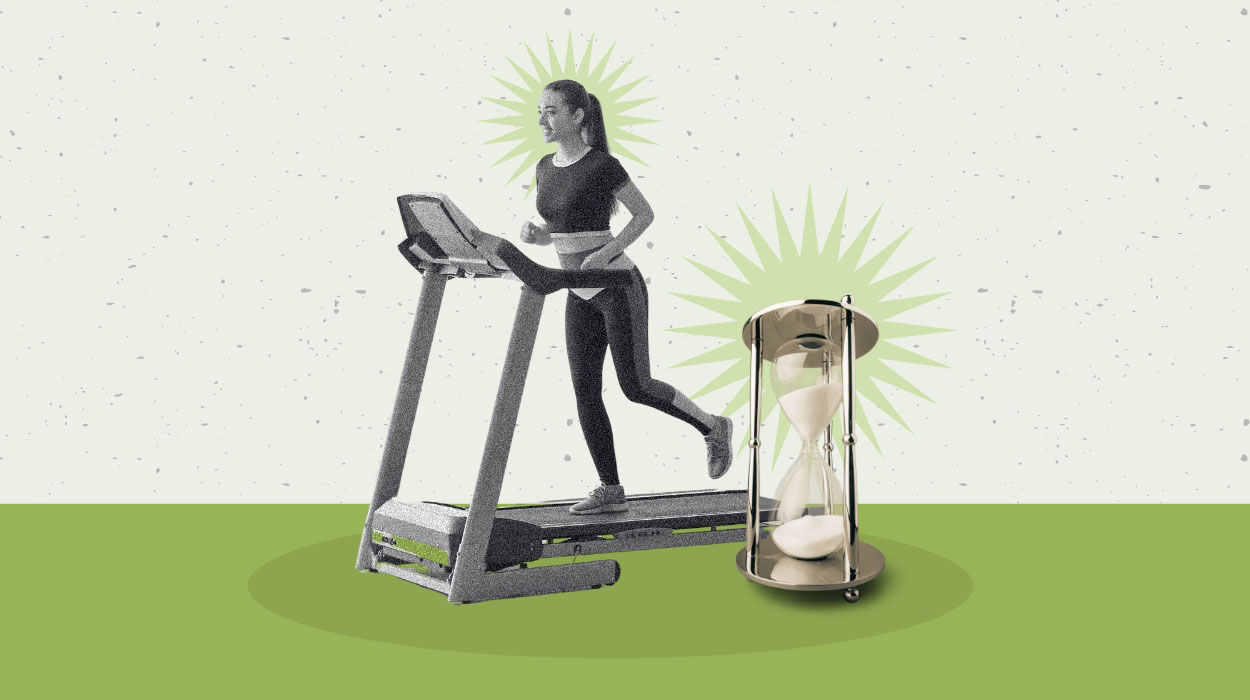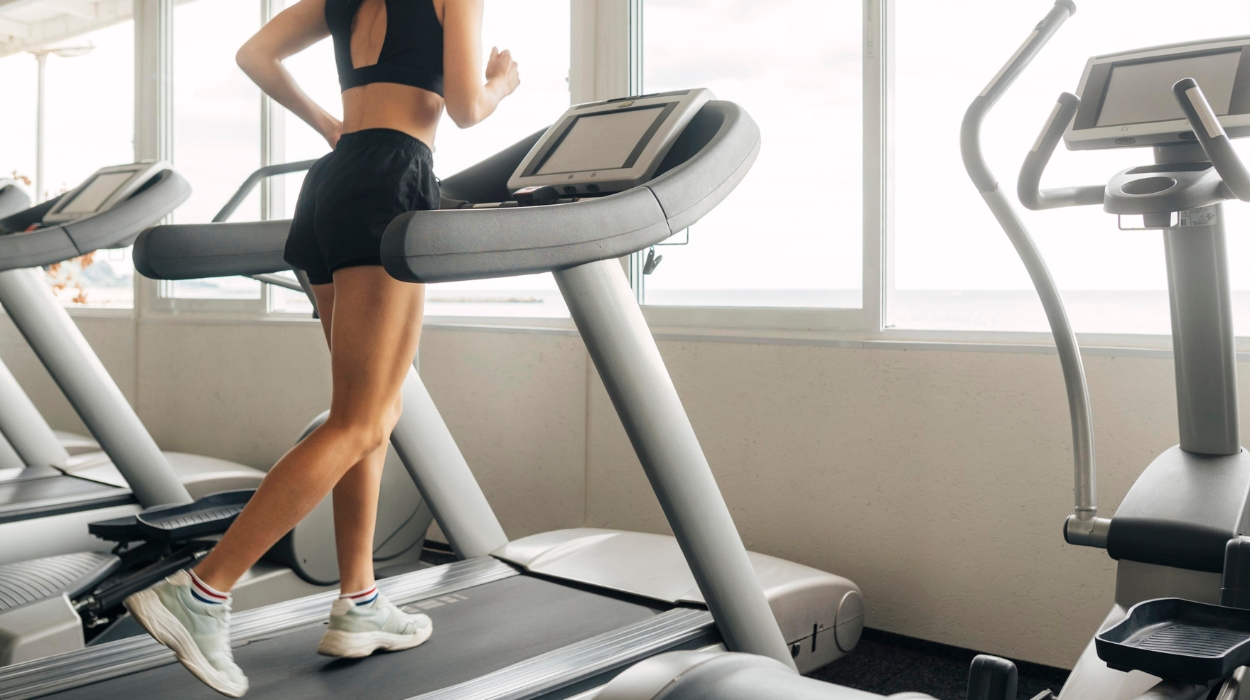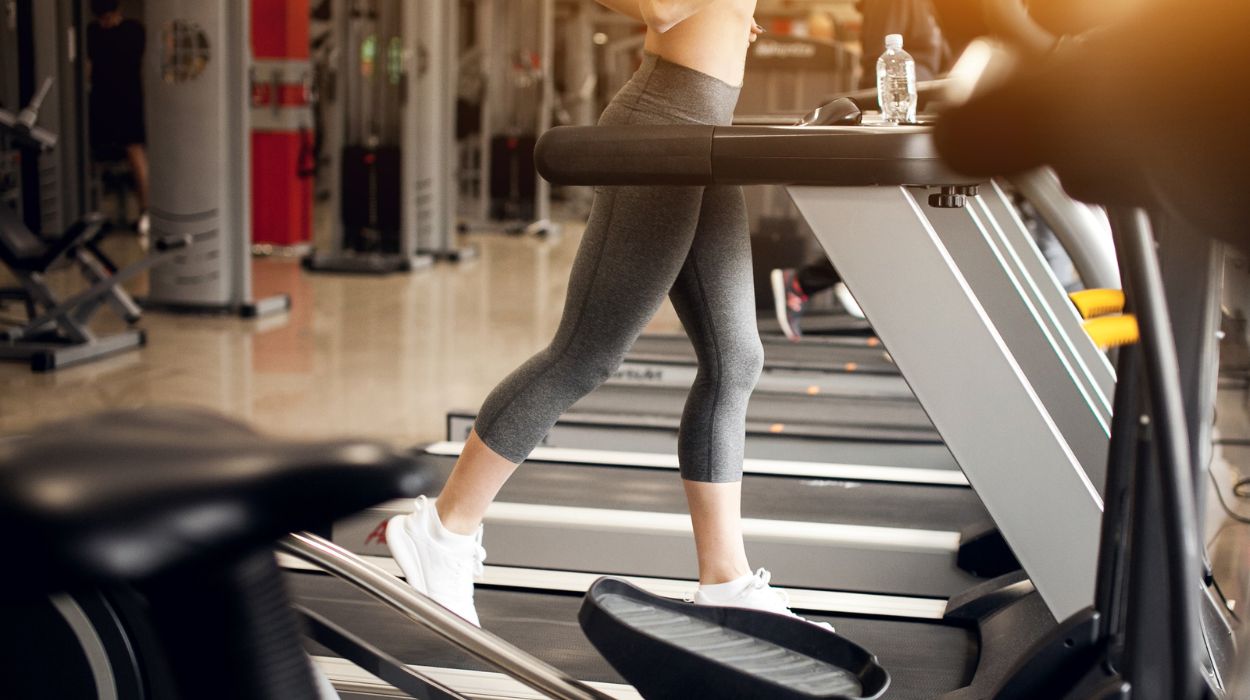
How long should you run on a treadmill to lose weight? It depends.
How fast are you running? How strong are your leg muscles already?
Contrary to popular belief, you can lose weight on a treadmill under many routines and circumstances.
The amount of time you use a treadmill won’t exactly determine how much weight loss you’ll experience. However, it’s certainly one way to keep track of your daily routine and chart the progress.
How Long Should You Run On A Treadmill?
- The ideal duration for a treadmill workout depends on your available time.
- The key is to focus on calorie burning.
- The length of your workout matters less than its intensity and effort.
How Long Should I Run On The Treadmill?

There is no minimum that you need to adhere to strictly. For many, the appropriate length of time is generally the amount of time you have to spare for the activity. More relevant to your calorie-burning journey will inevitably be the calories you’re able to expand while exercising.
When jogging at 5 mph, a 154-pound person is estimated to burn 590 calories per hour.[1] This makes exercise on a treadmill significantly more time-efficient than similar types of indoor physical activity.[2] These include using an exercise bike or an elliptical. If time is of the essence, treadmill workouts are well worth the investment.
The length of time you choose is less important than the nature of the workout. This also includes the effort you need to expend to keep up with the machine.
Mostly, any treadmill workout aims to elevate your heart rate and challenge your muscles with resistance and an incline.
Monitoring your heart rate with a heart rate monitor as you work out is important. It’s a great way to quantify the intensity of the activity and determine how hard you are working.
Of course, increasing the treadmill’s speed is one way to push it to the limit. This will improve your aerobic capacity and maximize your effort.
Your target heart rate[3] during moderate-intensity activity should be around 50 to 70% of your maximum heart rate. During vigorous activity, this rises to 70 to 85%.
Running faster and at a steeper incline throughout your treadmill workouts is great for high-intensity interval training. However, you don’t need to be taking it to the extreme as you run.
Taking it easy sometimes is a great way to stay active whilst giving your body time to recover.
What Speed And How Long Should Beginners Run On A Treadmill?
As a beginner runner, start at a lower intensity and gradually increase your duration. Make sure to perform a suitable warm-up.
The goal at this level should be to build a solid foundation and determine your starting fitness level.
The table below can be used as a guide for beginners. This is only an estimate and may vary depending on the individual.
| Running Pace | Expected Treadmill Beginner Speed Range |
| Walking | 3 to 5 kilometers per hour |
| Jogging | 6 to 9 kilometers per hour |
| Running | 10 to 12 kilometers per hour |
If performing at a higher-intensity, incorporate intervals as needed using a faster pace. Make sure you can run at the stated interval. Use the treadmill speed conversion table below as general guidance.
| Treadmill Belt Speed | Estimated Mile Pace |
| 3 miles per hour / 5 kilometers per hour | 20 minutes per mile |
| 4 miles per hour / 6.5 kilometers per hour | 15 minutes per mile |
| 5 miles per hour / 8 kilometers per hour | 12 minutes per mile |
| 6 miles per hour / 9.7 kilometers per hour | 10 minutes per mile |
| 7 miles per hour / 11 kilometers per hour | 8:30 minutes per mile |
Aim to run for 20 to 30 minutes. This should include a brisk 5-minute warm-up and cool-down for each session.
How Long Should You Run On The Treadmill: Factors To Consider
Your ideal treadmill run length is going to depend on several factors. The ones listed below are the main things to consider.
Fitness Level
As a beginner runner, your fitness level will be much lower compared to an intermediate or advanced runner. Due to this, you’ll be jogging for much shorter periods.
At an intermediate and advanced level, you’ll have spent months or years working on an efficient running economy. Your body will be far better adapted to handle the physical demands over longer periods.
Workout Goals
When deciding the run length, consider your workout goals. Someone who’s training for a 5K will have a much different workout length than someone training for a 10K.
Those training for a race, looking to lose weight, or get healthier will have different running workout lengths. Your workout goal will determine each run length that will be planned. Make sure you have clear goals in mind.
Time Availability
As our personal and professional lives change, our available time to workout often changes with it.
Plan the session appropriately according to your lifestyle. Use a balanced approach, ensuring your professional and personal time is also prioritized.
Physical Limitations
Understanding your physical health limitations should not be overlooked. When planning each session, consider your physical state. Factors such as your mobility and previous running times should be taken into account.
Throughout the run, you should be able to maintain proper form. You should keep an upright posture and try not to overuse the side rails unless necessary.
Workout Intensity
Whether you’re performing tempo runs, interval training, or HIIT can determine your run length. Your workout will be shorter when performed at a higher intensity than at a steady-state pace.
Health Benefits Of Treadmill Running
The health benefits of running on a treadmill are wide-ranging. The main ones are listed below.
Improved Cardiovascular Health
Performing regular aerobic exercise has been consistently shown to improve cardiovascular health.[4] Regular running can help to improve heart health, especially in individuals with high blood pressure.
Over a longer duration, running on a treadmill as part of a consistent exercise routine can reduce heart disease risk factors. This includes reducing your blood pressure and cholesterol levels.
Aids Weight Loss
Overweight individuals looking to lose fat and improve composition need a sustained calorie deficit.[5] Using a treadmill can be great for burning calories. It’s easy to do and can be enjoyable when done with friends.
Improved Bone And Joint Health
Most treadmills offer built-in shock absorption software under the belt, reducing the impact felt on each stride when exercising. Compared to outdoor running, completing it on a treadmill can provide a lower-impact workout surface that’s better for bone and joint health.[6]
Running both on a treadmill and outdoors can be used as part of a well-organized training plan. It can be used to reduce the amount of impact felt on bones and joints over longer training periods.
Walking On A Treadmill
Walking on a treadmill is also nothing to sneeze at—even physical activity at a leisurely pace can burn calories. If your fitness level isn’t stellar, a brisk walking pace for longer periods is a good option.
This gives you a great way to get into the swing of a new exercise program. As mentioned before, increasing the treadmill incline will also help you burn more calories and improve cardiovascular health.
The same goes for moderate-intensity exercise for even the fittest among us—marathon elite runners might consider watching a movie or reading a book while walking at a moderate level or jogging.
Moving at higher speeds might feel like the best way to meet your fitness goals. However, doing a warm-up and programming breaks is the best way to prevent injuring yourself.
How To Use A Treadmill: Top Helpful Tips
Work On Your Form

Like outdoor running, proper form[7] is the best way to burn calories and ensure your safety as your fitness levels improve. Factors such as stride length, stride rate, speed, and contact points all play a role. These aspects can impact your balance and the overall wear and tear that jogging regularly places on your body.
Consider watching videos on the subject on sites like YouTube—once you have a good idea of appropriate form, try practicing in front of a mirror to perfect your form as you run. Using music can also help you nail down your rhythm, as well.
Invest In The Right Running Shoes
Shoes built for running can help save your knees from the ground reaction forces and prevent injury. They’re also usually much more comfortable to exercise in and can help improve your athletic performance.[8]
Investing in other gear can help make running on a treadmill a much more immersive experience. This may include a heart rate monitor, supportive workout clothes, and even ankle weights for added challenge.
Fuel Up Right
Calorie intake is key when it comes to weight loss, but depriving yourself before exercising on a treadmill may be harmful. Fasted cardio[9] is one tactic to employ when losing weight, but the energy you expend can deplete you. If you do prefer to run on an empty stomach, recovery meals and shakes afterward are a must.
When you are nourished, it’s more equipped to build new muscle mass and maintain what’s already there. Without the right diet, burning belly fat by running on a treadmill might be more difficult; your metabolism will be slower, and you may not have the stamina[10] to work out at length.
Listen To Your Body
Improvements in motivation are one of the greatest overall mental health benefits that a new treadmill routine may offer. You might become more motivated[11] to continue after you finally begin. Some call it the runner’s high—all that we know is that when we’re feeling restless, nothing sounds better than an intense workout.
With that being said, you should never deny your body some rest if it’s calling for it. Eating well, meditating, stretching, and self-care can help you stay in tune with your needs.
Try not to force yourself to run at high speed if you’re feeling fatigued. An afternoon off might be just what the doctor ordered.
Burning fat on a treadmill might feel like an exhausting, impossible task to a beginner. However, as you progress, weight loss will come naturally. This is because your newly developed muscles become more capable of carrying you farther.
Read as much as you can online, and do what you can to try new types of treadmill workouts. Try it all and stick to the stuff you like—and, whenever possible, follow the advice of the experts.
Final Thoughts
What’s the best way to lose weight on a treadmill? How fast should you run on a treadmill? One strategy is to simply run as fast as you can until you can’t run anymore.
Interval training sessions can also aid you in weight loss by helping you sustain your workout at length. As long as you’re eating well, sleeping restfully, and finding the balance, long-term weight loss can occur.
Frequently Asked Questions
Aim to run for at least 20 to 30 minutes daily. Look to achieve the recommended 150 to 300 minutes of moderate-intensity aerobic exercise weekly.
Whether a 20-minute treadmill run is enough depends on several factors. These include workout goals, running pace, and experience level.
Faster running burns more calories and is more time efficient. It also requires more recovery time. Longer running improves endurance and requires less recovery. Both can be used efficiently based on individual needs.
Resources
- CDC (2023). Physical Activity for a Healthy Weight . [online] Centers for Disease Control and Prevention. Available at: https://www.cdc.gov/healthyweight/physical_activity/index.html#howMany.
- Filipovic, M., Munten, S., Herzig, K.-H. and Gagnon, D.D. (2021). Maximal Fat Oxidation: Comparison between Treadmill, Elliptical and Rowing Exercises. Journal of sports science and medicine, [online] pp.170–178. doi:https://doi.org/10.52082/jssm.2021.170.
- www.heart.org. (2021). Target Heart Rates Chart. [online] Available at: https://www.heart.org/en/healthy-living/fitness/fitness-basics/target-heart-rates.
- Pinckard, K., Baskin, K.K. and Stanford, K.I. (2019). Effects of Exercise to Improve Cardiovascular Health. Frontiers in cardiovascular medicine, [online] 6. doi:https://doi.org/10.3389/fcvm.2019.00069.
- Ju Young Kim (2021). Optimal Diet Strategies for Weight Loss and Weight Loss Maintenance. Journal of obesity & metabolic syndrome, [online] 30(1), pp.20–31. doi:https://doi.org/10.7570/jomes20065.
- Warden, S.J., Davis, I.S. and Fredericson, M. (2014). Management and Prevention of Bone Stress Injuries in Long-Distance Runners. The Journal of orthopaedic and sports physical therapy/Journal of orthopaedic and sports physical therapy, [online] 44(10), pp.749–765. doi:https://doi.org/10.2519/jospt.2014.5334.
- Folland, J.P., Allen, S.J., Black, M.I., Handsaker, J.C. and Forrester, S.E. (2017). Running Technique is an Important Component of Running Economy and Performance. Medicine and science in sports and exercise, [online] 49(7), pp.1412–1423. doi:https://doi.org/10.1249/mss.0000000000001245.
- Sun, X., Lam, W.-K., Zhang, X., Wang, J. and Fu, W. (2020). Systematic Review of the Role of Footwear Constructions in Running Biomechanics: Implications for Running-Related Injury and Performance. Journal of sports science & medicine, [online] 19(1), pp.20–37. Available at: https://www.ncbi.nlm.nih.gov/pmc/articles/PMC7039038/.
- Hassane Zouhal, Ayoub Saeidi, Salhi, A., Li, H., M Faadiel Essop, Laher, I., Fatma Rhibi, Sadegh Amani-Shalamzari and Abderraouf Ben Abderrahman (2020). Exercise Training and Fasting: Current Insights. Open access journal of sports medicine, [online] Volume 11, pp.1–28. doi:https://doi.org/10.2147/oajsm.s224919.
- Hargreaves, M. and Spriet, L.L. (2017). Exercise Metabolism: Fuels for the Fire. Cold Spring Harbor perspectives in medicine, [online] 8(8), pp.a029744–a029744. doi:https://doi.org/10.1101/cshperspect.a029744.
- Teixeira, P.J., Carraça, E.V., Markland, D., Silva, M.N. and Ryan, R.M. (2012). Exercise, physical activity, and self-determination theory: A systematic review. The international journal of behavioural nutrition and physical activity, [online] 9(1), pp.78–78. doi:https://doi.org/10.1186/1479-5868-9-78.




